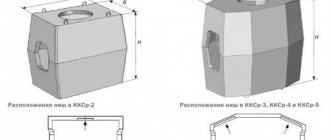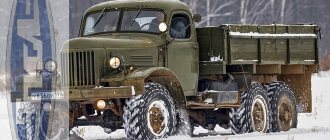Equipment of dump trucks
First, it should be noted that the truck has a relatively low cost. In addition, the vehicle has proven its reliability and maintainability. By the way, it is possible to repair a car not only in the garage, but also in the field. There are a sufficient number of spare parts for this dump truck model on the automotive market, so maintenance is not particularly difficult. If the GAZ 53 is operated correctly, then the engine will have to be overhauled no earlier than after 400,000 kilometers.
The dump truck has a strong body that can be lifted using an automatic device. GAS is supplied with 8.25 R 20 tires and a 90-liter gas tank. The front and rear suspensions of the car are spring-dependent, on the first of them there are telescopic shock absorbers. Drum-type brake systems are installed on the GAZ 53 wheels, but there is no hydraulic power steering, which makes it difficult to make turns.
The technical characteristics of this dump truck model have both positive and negative sides. The disadvantage is a small clutch resource, which creates problems regarding the smoothness of the start of movement. There are also some problems with the cardan shaft
: nuts can be unscrewed in it in those places that are connected using Hooke's hinges. The springs are not adapted to moving an overloaded truck on poor quality roads. Sometimes there are electrical problems. In addition, the crankshaft oil seal may be leaking.
A carburetor engine is installed on the GAZ 53 model, which is characterized by a fairly high level of fuel consumption, but the problem is solved by installing a diesel engine MM3 D-245
. The installation of such an engine quickly pays off (after about 40,000 kilometers). Over the entire history of production, engines of various capacities were installed on the dump truck, which determined the carrying capacity of the GAZ-53 car.
Prices and equipment
20 years ago, the production of GAZ 53 dump trucks was discontinued. In the automotive market, lovers of the Soviet automobile industry can purchase this car for 60-300 thousand rubles
(prices vary widely).
GAZ dump trucks equipped with a diesel engine are quite efficient vehicles for agricultural work, since such vehicles have high cross-country ability. Spare parts for dump trucks can be purchased at the automotive markets.
The photo below shows the prices for the GAZ-53 for comparison.
Specifications and chronology of the release of the model
GAZ-53F was produced in 1961-1967
, which was equipped with a six-cylinder engine of the GAZ 11 model and a four-speed gearbox, and the engine power was equal to 82 horsepower.
The maximum speed of the car was 74 kilometers per hour, and the fuel consumption was within 24 liters (when transporting 3.5 tons of cargo). Video
From 1964 to 1983, GAZ-53 and GAZ-53A
, having a four-ton carrying capacity. They also had a six-cylinder engine model ZMZ 53 with a capacity of 115 horsepower. The trucks had a transmission consisting of four gears. These cars were able to accelerate up to 85 kilometers, fuel consumption was 22-25 liters (taking into account the transportation of cargo weighing 3.5 tons).
The car model GAZ 53-12 was produced in 1983-1992. The carrying capacity of the vehicle was at the level of four and a half tons. The dump truck was equipped with a ZMZ 511 engine, which has 8 cylinders and a power of 120 horsepower. GAZ 53-12 could reach speeds of up to 90 kilometers per hour, but fuel consumption was already 25-30 liters. On the GAZ 53-19 truck produced in 1984-1992, a ZMZ-511 diesel engine was installed, which consumed methane and developed a power of 105 hp. The maximum speed of the car was 80 kilometers.
GAZ 53-27 was produced in the same years as the previous model. The car had a ZMZ model 511 engine that consumed propane. The engine power was 100 horsepower, the speed was not higher than 80 kilometers.
A milk tanker is a car with large tanks attached to its cab. GAZ-53 is a Soviet truck. Belongs to a series of medium-duty trucks. It began to be produced in October 1961 and until 1992 at the Gorky Automobile Plant. These machines were the most common among trucks in
Soviet Union. For more than thirty years, more than 4 million cars have taken to the roads from the assembly line of the plant. All branches of the national economy of the country used the worker of the Soviet era - GAZ-53. The convenience of the driver was not thought at that time, and inside the cabin was simple and uncomfortable. For the driver and passengers there was one common sofa with a back and a small place for things in the back. For its time, the GAZ 53 looked very modern. The frame of the car was very durable. The gas tank was installed under the driver's seat.
And the filler neck was behind the cab, at the edge of the driver's door. This turned out to be very convenient when cars were switched to gas fuel. The gas cylinder was installed under the body. From 1983 to 1991, the GAZ 53 was assembled at the Bulgarian Madara enterprise. The car was exported to Poland, Romania, Germany, Czechoslovakia, Vietnam and Mongolia.
On the GAZ-53 chassis, they produced a wide range of models for various transportation. These included an onboard GAZ-53, a milk carrier, a ladder truck, a mobile repair shop, and a fuel truck. To transport milk, tanks were fixed behind the cab of the car. Tanks have one or two sections. The total capacity of the sections ranges from 3900 liters to 4200 liters.
The tanks have tight-closing hatches with dust caps. And these lids protect the product from external influences. Draining and filling of tanks with milk occurs by means of a pump through pipelines. The milk tanker is sheathed on both sides, external and internal, with stainless corrosion-resistant steel. Between these layers, a thermal insulation layer with a thickness of at least 4-5 cm is necessarily laid. Even with a temperature difference of up to 30 degrees, milk can change the temperature by no more than 2 degrees. This layer allows you to keep the desired temperature of milk for a long time, up to 10 hours.
Milk tankers are made in an elliptical shape. In order to increase the safety of transportation. The center of gravity in such tanks is at the bottom, lower than in tanks with a round tank. Outside, the tanks are covered with metal sheet boards. In order to be able to walk along the cistern, handrails and a folding ladder are installed. Tankers of milk trucks can carry various food liquids.
They carry milk, water, beer, kvass, vegetable oil and live fish.
The GAZ-53 milk carrier was discontinued more than 20 years ago. But these machines are still in service. Over the years, the car has proven to be a reliable, maintainable and technically simple truck.
One of the types of tankers are - they were also produced quite a lot on the basis of the GAZ chassis.
The first tank trucks were an iron tank, which was mounted on a frame of beams and fastened with clamps. The composition of the barrel for the transportation of liquid fuel included special fittings, consisting of a cleaning filter and a safety valve that relieved excess pressure of gasoline or kerosene vapors. Two shut-off valves were mounted at the bottom of the barrel - with the help of them, fuel from the tank was drained by gravity through flexible hoses.
Tank truck based on GAZ 51 for the transportation of petroleum products
After the Great Patriotic War, the first fuel truck in Gorky was the tanker ATs2-51 on the chassis, the car went into series in 1950. The car had a capacity of 2,000 liters and carried mainly kerosene and gasoline. Also, GAZ vehicles were intended for the transport of food products.
The ABB-2 tank was used to transport drinking water, the ATsPT-1.8 model delivered milk, the equipment was used to transport vegetable oil, live fish, and beer. The last digits in the name of special vehicles testified to the capacity of the barrel - so for a milk tanker it is 1.8 m³. It was much more profitable to transport milk in a barrel than in flasks:
- You can immediately transport a large volume;
- The product did not turn sour for a long time, since the tank was isothermal, and the milk in it did not heat up.
More than one modification of fire engines was assembled on the basis of GAZ 51 - there were several cars. The most common were the PMG-6 and PMG-12 models.
Reliable worker GAZ-53 milk carrier
A milk tanker is a car with large tanks attached to its cab. GAZ-53 is a Soviet truck. Belongs to a series of medium-duty trucks. It began to be produced in October 1961 and until 1992 at the Gorky Automobile Plant. These cars were the most common among trucks in the Soviet Union.
For more than thirty years, more than 4 million cars have taken to the roads from the assembly line of the plant. All branches of the national economy of the country used the worker of the Soviet era - GAZ-53. The convenience of the driver was not thought at that time, and inside the cabin was simple and uncomfortable.
For the driver and passengers there was one common sofa with a back and a small place for things in the back. For its time, the GAZ 53 looked very modern. The frame of the car was very durable. The gas tank was installed under the driver's seat.
And the filler neck was behind the cab, at the edge of the driver's door. This turned out to be very convenient when cars were switched to gas fuel. The gas cylinder was installed under the body. From 1983 to 1991, the GAZ 53 was assembled at the Bulgarian Madara enterprise.
The car was exported to Poland, Romania, Germany, Czechoslovakia, Vietnam and Mongolia.
On the GAZ-53 chassis, they produced a wide range of models for various transportation. These included an onboard GAZ-53, a milk carrier, a ladder truck, a mobile repair shop, and a fuel truck. To transport milk, tanks were fixed behind the cab of the car. Tanks have one or two sections. The total capacity of the sections ranges from 3900 liters to 4200 liters.
The tanks have tight-closing hatches with dust caps. And these lids protect the product from external influences. Draining and filling of tanks with milk occurs by means of a pump through pipelines. The milk tanker is sheathed on both sides, external and internal, with stainless corrosion-resistant steel.
Between these layers, a thermal insulation layer with a thickness of at least 4-5 cm is necessarily laid. Even with a temperature difference of up to 30 degrees, milk can change the temperature by no more than 2 degrees. This layer allows you to keep the desired temperature of milk for a long time, up to 10 hours.
Milk tankers are made in an elliptical shape. In order to increase the safety of transportation. The center of gravity in such tanks is at the bottom, lower than in tanks with a round tank. Outside, the tanks are covered with metal sheet boards. In order to be able to walk along the cistern, handrails and a folding ladder are installed.
In the tanks of milk trucks, you can carry various food liquids:
- milk
- water
- beer
- kvass
- vegetable oil
- live fish
The GAZ-53 milk carrier was discontinued more than 20 years ago. But these machines are still in service. Over the years, the car has proven to be a reliable, maintainable and technically simple truck.
GAZ 53 tank trucks
Here are some technical characteristics of a fuel truck on the GAZ 53 chassis:
- Car dimensions - 6.2 / 2.4 / 2.6 m;
- The distance between the axles (wheelbase) - 3.7 m;
- Gross vehicle weight - 7.15 tons;
- The volume of the tank is from 4.2 to 4.8 m³, depending on the modification;
- Ground clearance - 26.5 cm;
- Refueling capacity of the gas tank - 90 liters.
A 4.25-liter gasoline engine was standardly installed on tankers from the factory, its power was 115 liters. With. Due to the fact that the engine is rather "gluttonous", many car owners changed the gasoline internal combustion engine to a more economical and torquey diesel engine. You can often find on the "53rd" the diesel engine of the Minsk Motor Engine was equipped with a mechanical 4-speed gearbox, both suspensions (front and rear) were leaf springs.
Specifications
Technical characteristics of the GAZ-53 fuel truck:
| Characteristics | Indicators |
| Weight, kg: | |
| - common to the entire unit | 7157 |
| - base chassis | 3470 |
| Dimensions, mm: | |
| - length | 6190 |
| - width | 2380 |
| - height | 2590 |
| Vehicle base length, mm | 3700 |
| Ground clearance, mm | 245-265 |
| Engine parameters, hp, brand / power | ZMZ-53/125 |
| Engine volumes, cm3 | 4254 |
| Fuel consumption per 100 km, l | 25-28 |
| Max speed, km/h | 85 |
| Tank brand | 806 (AC-4.2-53A), 808 (AC-4.2-53A) |
| Capacity (volume) of a barrel, l | 4200-4800 |
| The highest allowable density of transported oil products, g/cm3 | 0,86 |
Video review of the GAZ-53 fuel truck:
Tank trucks GAZ 3307 and 3309
Fuel trucks
Tank trucks AC-4.9 are made on the chassis and special vehicles are designed for the transportation of petroleum products. The tank is filled with a pump from above, the liquid fuel is drained by gravity. To prevent arbitrary leakage of liquid, a shut-off valve is installed, the injection pump is powered by a power take-off.
The tank truck has the following specifications:
- Curb weight (without cargo) - 3.63 tons;
- Car dimensions - 6.4 / 2.4 / 2.6 m;
- The distance between the axles (wheelbase) - 3.77 m;
- Gross vehicle weight - 7.9 tons;
- The volume of the tank is 4.9 m³;
- Ground clearance - 26.5 cm;
- Filling capacity of the gas tank - 105 l;
- Wheel drive - rear (4x2).
The barrel is made of black or stainless steel with a thickness of 3 mm, the cross section of the tank is oval.
Currently, cars based on GAZ 3307 are no longer produced (out of production), AC-4.9 cars are assembled at MMZ D-245.7 and Cummins ISF. Since 2013, the GAZ 33098 chassis began to be equipped with the engine of the Yaroslavl Motor Plant YaMZ-5342.
Vacuum trucks
The vacuum machine works on the principle of liquid capture due to the vacuum that is created in the tank by a vacuum pump. Liquid continues to flow into the barrel until the tank is completely filled. When the container is full, a special sensor is triggered, an audible signal sounds, and the vacuum pump automatically stops its work. The liquid is drained from the barrel by gravity - a stopcock opens to drain. On the basis of the GAZ 3309 chassis, the KO-503V-2, KO-522B and KO-503V-3-01 sewage trucks were created.
Vacuum truck GAZ 3309
Models differ from each other in the volume of the tank, the KO-503V-3-01 car, in addition to everything, can still transport dry closets.
Tankers for the delivery of food liquids
There are tankers on chassis 3309, designed to deliver food liquids - milk, kvass, drinking water and other products. The barrel is specially designed for the transportation and storage of such liquids - the inner walls are made of food-grade aluminum. The tank itself is sealed, and the heat-insulating layer allows you to store milk or kvass in a container for a long time. Milk trucks GAZ 3309 are equipped with anti-slip handrails around the tank, the barrel is filled using a pump built into the machine.
Fuel truck GAZ-53
The main feature of these tankers is the chassis manufactured by the Gorky Automobile Plant with the GAZ-53 marking, which were produced in serial form from 1961 to 1993. They are medium-duty vehicles of the third generation from the GAZ model range of similar carrying capacity, over the years of production, the total number of vehicles has exceeded 4 million units. Having become the most massive Soviet truck, this car had many modifications - dump trucks, truck tractors, fire trucks, milk trucks, fuel trucks, etc.
The advantages of using the GAS base for the transportation of gasoline products come from the following factors:
- The reliability of the machine itself;
- The simplicity of the device and, as a result, the availability of current repairs;
- Long engine life - up to 400 thousand kilometers;
- The ability to accommodate up to 3 people in the cabin, which allows personnel to change in management and participate in joint actions in the event of an emergency;
- All-metal structures that ensure the safety of maintenance;
- The cheapness of spare parts used in repair work.
An elliptical tank is installed on the base chassis, which gives the vehicle the greatest compactness and maneuverability in urban areas. At the same time, the machine is adapted to the conditions of the Russian climate and roads, both in terms of the cargo base and the tank capacity.
Photo of a fuel truck based on GAZ 53











